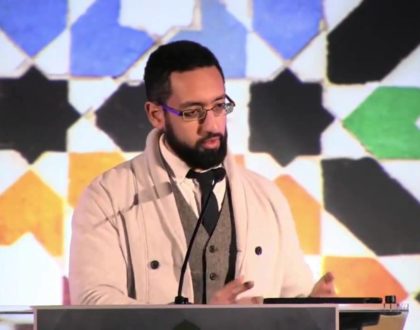Where Lies The Right Sunnah of Prophet Muhammad

June 27, 2017
By: Faysal Burhan
Published: 2002
Allah (SWT) said:
There has undoubtedly been a perfect pattern for you in the Messenger for anyone whose hope is in Allah and the Last Day and who remembers Allah often. Qur’an 33:21
Summary
To understand the accurate Sunnah of the Prophet Muhammad’s peace to be upon him, PBUH is to know how he successfully weights, fashioned, and managed his work originating from his era’s sociopolitical, cultural, and technological aspects. The Sunnah is incorrectly, cosmetically interpreted as a form of wear and look. Moreover, in some other instances of interpretation, the Prophet’s means become a Sunnah and more-less the goal. Such understanding demands the 7th-century tact and lifestyle coercion and implementation irrespective of the era, place, or culture. Such irrational practices led to the failure and stagnation of Muslims. The Sunnah of Prophet Muhammad must be extracted and deduced from his forethought trait, the creation of solutions, innovations, management style, and actual labor.
Discussion
The Prophet’s management method, the local traditions, the geopolitical structure, and the tackles he used are separate items considered in figuring out the actual and accurate Sunnah.
Prophet Muhammad (PBUH) managed his daily work by employing society’s culture, the elements, and the means available into workable resolutions. The Prophet Muhammad objectively tailored existing mechanisms and customs into meaningful answers. However, one must remember that the tools and the culture available to him may not be the same for other people, times, and places. Therefore, the genuine Sunnah of Prophet Muhammad lies merely in his approach and management, utilizing the existing society’s customs and means. Let us consider a few examples to expound on the idea.
a) The Trip to Al-Taif
Substantiating the claim that the genuine Sunnah of the Prophet Muhammad is to utilize people’s sociopolitical structure, customs, and technology into meaningful solutions, let us examine the story confining his trip to al-Ta’if. Al-Ta’if is a mountain town about 90 miles south of Mecca. The trip took place during the 10th year after the first Revelation. For many years, the Meccans Quraysh closely monitored Prophet Muhammad—disrupting his contact with people and endeavors to deliver his message—setting blockade acts for intimidation, mistreatment, and harassment—labeling him a fool, magician, and liar. The Meccans barred their people from speaking to him, including merchants and pilgrims entering Mecca. They even tortured and killed some of his companions, who had no tribal protection.
The close watch, hardship, restrictions, and rejections forced the Prophet to seek other communities for his call, such as the tribes of Thaqeef in al-Ta’if. Our interest in this trip is to study the Prophet’s way of evading Quraysh’s attention as he leaves Mecca for a lengthy and dangerous journey. Let us not forget that his tribe and relatives assured Muhammad’s protection in Mecca, but Muhammad could easily have been killed outside Mecca if Quraysh had learned of his travel.
It was customary in Arabia for a traveler to get a goodbye ceremony. Typically travel ceremonies are attended by the leader of the tribe and essential members of the community. The travel embarks point is primarily important, and a flaunt point.
The genius of the Prophet shines out as he walks out of his home for the journey with his servant Zaid ibn Harithah, then known as the son of Muhammad, without his uncles, wife, daughters, or any of his companions, not even a camel for carrying the travel goods.
At the least, this ordinary and casual start would send a message to Quraysh’s watching eyes that Muhammad was out for a stroll—warranting no primary concern to monitor his movements further. As a result, no further attempts were made to know where he was going. With this simple technique, the Prophet could travel to al-Taif and return safely without Quraysh’s knowledge or intervention.
What does this story illustrate to Muslims as an authentic Sunnah to be acted upon? Is it the simplicity of travel, the travel in daylight, or having no transport for the travel gear? Even though some people happily take these criteria as a Sunnah, the Prophet’s lesson demonstrates that the Sunnah is building an approach based on the acting circumstances and people’s culture, which allowed for a successful answer. The answer, in this case, is evading Quraysh for a dangerous endeavor. Instead, he could go to al-Ta’if, conduct his business, and return safely to Mecca. Such plans and execution are nothing short of sound management, implementing simplicity, complexity, and arrangements as the situation may dictate.
Circumstances, culture, and elements change from one society to another, but the proper management in deploying the existing culture always works with any conditions, times, places, or customs. Therefore, for today’s Muslims, the Sunnah taken from this trip is the invention and design of sound solutions to the particular issues facing them, arising from the 21st century’s local traditions and sociopolitical environment.
For those interested in learning the rest of the Prophet’s journey to al-Ta’if and his return to Mecca heartbroken, please visit – Muhammad’s Journey to al-Ta’if and Flexibility in Approach.
b) The Migration to Yathrib
Another example of the Prophet’s well-thought management is his migration to Yathrib, an oasis north of Mecca, later named Medina. Escaping Quraysh’s latest plot to kill him, the Prophet and his close friend Abu Bakr headed south and hid in a mountain cave called Thawr instead of traveling north directly to Medina, where Quraysh expected him to join the rest of his companions there. Instead, they stayed in the cave for three days until the Meccans depleted the means of searching for them.
Expecting the Prophet’s arrival, Medinan Muslims set out to receive him for days, but he did not show up as expected. He took the long coastal road to evade his captors further instead. There is more to the Prophet’s migration than those well-thought-out actions. He hired a travel expert to lead him through the coastal route into Medina. Moreover, he could get all the news of what was happening in Mecca during his hide-out as Abu Bakr’s daughter brought the news and food to the cave at night. The Prophet also had Abu Bakr’s servant graze a herd of sheep after them to erase their footprints.
Again, what can be taken as a Sunnah from his escape and emigration example? What is definite as an answer is planning and management, not haphazard or incomplete work. Similarly, labor and ventures based on sound craft will make nations prevail and flourish.
The Outward Appearance
As for the outward issues and attires, the Prophet’s appearance and dress were no different or unique from his people. Muslims’ and Pagans’ outward expressions were the same. Arabia’s dress was tailored to endure the high heat, sunstrokes, and desert storms. This type of clothing in cold regions, such as Siberia, Moscow, or Alaska, can severely harm or even cause death, something Islam prohibits. If the Prophet Muhammad’s way of appearance and dress is not odd to his community, should not the Muslim’s motivations be the appearance of their community instead of Arabia’s 7th-century clothing?
The believer’s goal in Islam is to advance spirituality, closeness to Allah, and benefit the community. Moreover, strange appearances and cosmetics can undermine the purpose and success of the mission. Remember that looking odd in the West may be derogatory and hinder the goal.
The Prophet Approaches and Al-Hikmah (Wisdom)
The Hikmah, wisdom, a primary teaching element in Islam, appropriately dictates management affairs at the right time and at the right place. The Prophet was appointed to teach Hikmah (Qur’an 2:129). Why little or no attention is given to this Sunnah–a model of approach and management which would work for every time, place, and culture.
Muslims need not establish the customs of 7th-century Arabia to practice Islam in the 21st century. Muslims would exercise the Prophet’s precise Sunnah by constructing approaches based on the traditions and logic their contemporary people identify with; otherwise, backwardness and failures are expected. Let us examine how the Prophet determined the timing of Ramadan in the terms available in his era and then contrast it to our day and time as an example.
Today, many Muslims embrace the physical presence or absence of the crescent that Prophet Muhammad used to point to for the start and end of the lunar months. While this method deploys certainty and could be the best way for its purpose in the 7th century, it is inconclusive and sometimes unpractical in the 21st century. Surrounding this topic, we find several Traditions (Hadith) that Prophet Muhammad stated. However, each Tradition or group takes on a different method for determining the lunar month’s timing than the other.
These traditions’ mechanisms reflect the limited knowledge of astronomy and calculations in Mecca in the 7th century, which does not quite serve the topic, even during the Prophet’s days, as he pointed out.
For example, a group of traditions points out the number of days in a lunar month, while others speak about the number of days in three consecutive months. Another more accurate one revealing the beginning or end of the lunar month of fast is that which the Prophet (p) stated:
“Sumo le ru’ateh, wa aftiru le ru’ateh…” “Fast when you see the crescent and break your fast when you see the next crescent, but if you cannot see it, then complete the 30 days [in fasting].”
Seeing the crescent by the naked eye option pointed out by the Prophet, allowed for greater certainty. Still, as the Prophet points out, the formula is not the ultimate since he recommends fasting on the 30th day, a worst-case scenario if clouds or other circumstances obstructed the crescent.
“But if you could not see it, then complete the 30 days [in fasting].” -Bukhari & Muslim
Alongside these traditions, the Prophet points out what is lacking in his day and time, stating:
“We are Ummah (a nation) Ummiyah (unlettered) we do not write [in astronomical circles,] nor do we calculate [to arrive at the exact lunar dates.]…,”
Exploring the various methods available to him in the 7th century, but still with their inconclusive solutions, proves that the Prophet searched for the best solution for determining the begging and end of fasting. However, in the latter Tradition, the Prophet alludes to the issues contributing to the complications of seeing the crescent that it requires more astronomical knowledge and the ability to calculate.
Modern science states that the new moon’s birth occurs precisely when it is in a straight line between the Sun and the Earth, where no reflection of the Sun on the Moon is ever possible. But concerning the crescent’s visibility, astronomers say it can take up to 14 to 24 hours before the naked eye can see it. Furthermore, they indicate that there is more difficulty in discerning the Sun’s reflection on the moon due to several factors: The Sun’s refection size, the moon’s degree over the horizon, the moon’s orbit, the glare of the Sun, the short time of appearance, and the human eye vision variations.
A more difficult observation of the crescent is imposed because of these complications, demanding more information and predictions. For this reason, the beginning of Ramadan can be as much off as two days, even when taking the naked-eye best alternative available during the days of the Prophet.
In our days of technological advances, and with the speed of time consideration, modern technology and astronomy allow for far more accurate determinations, which the Prophet pointed out, as explained earlier. Therefore, using these elements to manage Ramadan and Eid’s precise timing is a Sunnah. Moreover, to solve today’s imposed problems due to the ever-advancing life and trends, Muslims must adopt advanced solutions for the timing of their feasts and religious occasions that are optimistic, workable, flexible reliable. Providing for these facets are indeed the “accurate” Prophetic Traditions Allah encourages us to follow.
For more details on this topic, please see our posted article, “The Profound Wisdom of Prophet Muhammad Regarding the Lunar Dates and the Unity of the Muslims.”
Taking the Step to Engineering Solutions
The problem of building solutions based on modern customs, needs, and technology demands of Muslims renovation of their understanding of the Qur’anic and Prophetic Traditions interpretations in terms of our era – information availability, easy accessibility, and the speed in answering demands make it mandatory to re-interpret the creed elements in today’s language. It is impractical, if not ridiculous, for Muslim workers or business owners not to give their superiors or workers the exact time to take off for their religious holiday, even the night before.
Muslims have to be able to step out of the box, “I cannot deviate from old fatwas,” and retire what could be bad ideas. Besides, being told what to do and how to do it decapitates creativity and imposes laziness and passivity – the unfortunate case of many Muslim societies today—on the other hand, making an achievement moderate or superior demands optimistic, proactive, and crucial thinking.
The Qur’an invites all people to its guidance—exploring its concepts, presumptions, premises, principles, and aspects for their benevolence. Contemplate the following passages:
2:2 ذلك الكتاب لاريب فيه هدى للمتقين
This is the Book about which there is no doubt. It is guidance to the God-conscious. Qur’an 2:2
54:17 ولقد يسرنا القران للذكر فهل من مدكر
And We have made the Qur’an easy to understand and remember: who is willing to take it to heart? Qur’an 54:17
The following passage invokes people to contemplate and scrutinize the Qur’an:
38:29 كتاب انزلناه اليك مبارك ليدبروا اياته وليتذكر اولوا الالباب
[Here is] a Book which We have sent down upon you, full of blessings, that they may reflect upon its signs [intensely deliberate through its suppositions, predictions, expressions, discover its conceptions and incites], and that men of understanding may receive admonition. Qur’an, 38:29
While Qur’anic expressions and inspirations are suitable for every time and circumstance, only by the intense and purposeful study can these idioms be realized and their fruits utilized.
As custodians of the Earth, the Holy Qur’an gave people the responsibility of innovation:
67:2 الذي خلق الموت والحياة ليبلوكم ايكم احسن عملا وهو العزيز الغفور
[He] Who created death and life to test you [as to] who of you is best in action – and He is Exalted in Might, the Forgiving. Qur’an, 67:2
“Best in accomplishment” means competition, creativity, and novelty. Stagnation and idleness must have no place in Islam.
76:2 انا خلقنا الانسان من نطفة امشاج نبتليه فجعلناه سميعا بصيرا
Indeed, We created man from a sperm-drop mixture to test him, making him hear and see. Qur’an, 76: 2
The faculties of hearing and seeing are aids for making optimal moves and decisions to achieve a healthy and better life.
47:24 افلا يتدبرون القران ام على قلوب اقفالها
Then, do they not [ponder, bring out, weigh carefully] and reflect upon the Qur’an, or do they lock up their hearts? Qur’an, 47:24
Muslims must deliberate and invent—produce results and actions. Cosmetics and Arabia’s 7th-century solutions and customs are no substitution for the more sophisticated 21st century.
The Collation of the Verse and Suras of the Qur’an
During the Prophet Muhammad (p), the Quranic verses and suras were not collated into one volume like today. After the Prophet passed, the Muslims faced extreme circumstances requiring new considerations and engineering. During the Caliph Abu Bakr’s rule, many of the companions of the Prophet, who had memorized the Qur’an killed in the battle of Yamamah. Umar ibn al Khattab, who later became the second caliph, was concerned about losing the Qur’anic revelations. Therefore he approached the Caliph Abu Bakr, requesting him to collate the Holy Qur’an. The following Tradition, 129 of Sahih Bukhari tells us the rest of the story:
Narrated Zaid bin Thabit Al-Ansari, who was one of those who used to write the Divine Revelation, said:
“Abu Bakr sent for me after the (massive) casualties among the warriors (of the battle) of Yamama (where a significant number of Qurra’ [those who know the Qur’an by heart] were killed). Umar was present with Abu Bakr, who said, ‘Umar has come to me and said, the people have suffered heavy casualties on the day of (the battle of) Yamama, and I am afraid that there will be more casualties among the Qurra’ at other battlefields, whereby a large part of the Qur’an may be lost unless you collect it. And I believe that you should collect the Qur’an.’
Abu Bakr added, I said to Umar, ‘How can I do something Allah’s Apostle has not done?’ ‘Umar said (to me), ‘By Allah, it is (really) a good thing.’ So Umar kept pressing, trying to persuade me to accept his proposal, till Allah opened my heart, and I had the same opinion as Umar.” (Zaid bin Thabit added): Umar was sitting with Abu Bakr and was not speaking. ‘You are a wise young man, and we do not suspect you (of telling lies or of forgetfulness): and you used to write the Divine Inspiration for Allah’s Apostle. Therefore, look for the Qur’an and collect it (in one manuscript).’
By Allah, if he (Abu Bakr) had ordered me to shift one of the mountains (from its place), it would not have been harder for me than what he had called me concerning the collection of the Qur’an. I said to both of them, ‘how dare you do a thing which the Prophet has not done?’ Abu Bakr said, ‘By Allah, it is (really) a good thing.’ So I kept arguing with him until Allah opened my chest for that which He had opened the chests of Abu Bakr and Umar. So I started locating Qur’anic material and collecting it from parchments, scapula, leaf stalks of date palms, and memories of men (who knew it by heart). I found with Khuzaima two Verses of Surat-at-Tauba which I had not found with anyone else (and they were):–
“Verily there has come to you an Apostle (Muhammad) from amongst yourselves. It grieves him that you should receive any injury or difficulty. He (Muhammad) is ardently anxious over you (to be rightly guided).'”
The previous story of the collation of the Qur’an is a living example confirming the engineering of solutions in response to changing conditions or demands. Similarly are the inventions of the Science of Hadith, the Science of Fiqh (verdicts), the Science of Interpretation of the Qur’an, the Science of the Punctuation of the Qur’an, and the Science of Arabic Grammar, which took place during the few hundred years after the death of the Prophet. Such new creations partially fulfill the demand for exploration and research that Islam laid on its adherents. These and other inventions reflect the dynamics and genuine nature of Islam and the Qur’an.
The magnanimous companions of the Prophet and those who followed them are proof of Muslim’s quest for intellect, discovery, design, and the bringing forth solutions to the present issues to enable the vehicle of Islam and Da’wah in progress.
Muslims today have fallen behind the world’s nations for failing to recognize the exact model of the Prophet Muhammad (PBUH) and what is his correct Sunnah. Creative thinking and management of business and affairs are essential elements of life. Muslims must engage in the actual labor of creativity, hasten the building of research institutions, and be technologically advanced to provide answers to the modern-day demand. Only then do they begin to follow the correct Sunnah of their Prophet. The author strongly recommends that the reader visit the article, Innovations: An Integral Part of Muslim’s Life.
Other Related Articles:
The Sunnah of Itqan (Precision)
The Sunnah of Planning in Islam
The Sunnah of Careful Consideration, Tathabu
Innovations: An Integral Part of Muslim’s Life.




